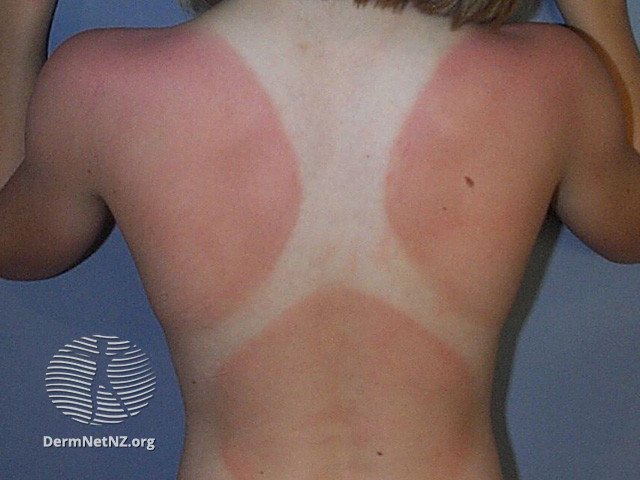
Sunburn
Sunburns are more common in patients with fair skin tones due to the lack of melanin.
Credit: DermNet NZ
What is a sunburn?
A sunburn is an inflammatory response of the skin to excessive ultraviolet (UV) radiation exposure, primarily from the sun but also from artificial sources like tanning beds. It results in skin redness, warmth, and discomfort, and in severe cases, blistering can occur. Chronic exposure to sunburns can also increase the risk of skin cancers, including melanoma.
What causes a sunburn?
A sunburn is caused by the skin's exposure to UV radiation beyond its capacity to protect itself. The skin produces a pigment called melanin as a defense against UV radiation. However, prolonged or intense exposure can overwhelm this defense mechanism, leading to cellular damage in the outer layers of skin. Both UVA and UVB rays contribute to sunburn and cellular damage.
What are the symptoms of a sunburn?
The signs and symptoms of a sunburn usually appear within a few hours after sun exposure and may include:
Redness and warmth
Pain and tenderness
Swelling
Skin that feels warm to the touch
Small fluid-filled blisters, which may break
Peeling skin as the sunburn heals
Severe reactions (sun poisoning), characterized by fever, chills, nausea, or rash
Eyes that feel painful or gritty
How do I treat a sunburn?
Treatment focuses on relieving discomfort and reducing inflammation:
Cool the skin: Apply cold compresses (like a cloth dampened with cool water) or take a cool bath.
Apply a moisturizer: Aloe vera or over-the-counter creams can soothe and moisturize sunburned skin.
Stay hydrated: A sunburn draws fluid to the skin's surface, so drink plenty of water to prevent dehydration.
Avoid the sun: Stay out of the sun while the burn heals to prevent further damage.
Over-the-counter pain relief: Non-prescription pain relievers, like ibuprofen or acetaminophen, can help reduce pain and inflammation.
Protect your skin: As the sunburn heals, wear protective clothing and apply sunscreen with an SPF of 30 or higher.
How do I prevent a sunburn?
Prevention is essential to avoid the discomfort and potential long-term effects of sunburns:
Wear Sunscreen: Choose a broad-spectrum sunscreen with an SPF of 30 or higher. Reapply every 2 hours and after swimming or sweating.
Seek Shade: Limit direct sun exposure during peak UV hours, usually between 10 a.m. and 4 p.m.
Wear Protective Clothing: Wide-brimmed hats, long-sleeved shirts, and long pants can shield your skin from the sun's rays.
Wear UV-blocking Sunglasses: Protect your eyes from harmful UV rays which can lead to cataracts.
Avoid Tanning Beds: Artificial UV radiation can cause skin damage and increase the risk of skin cancer.
Be Extra Cautious Near Water and Sand: Both can reflect and amplify the sun's damaging rays.
The peeling of dead skin cells seen after a sunburn.
Credit: DermNet NZ
Sunburn can also result in new mole development somewhat rapidly.
Credit: DermNet NZ



